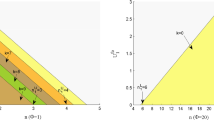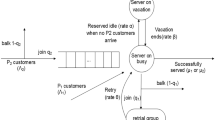Abstract
We study the economic analysis of a single server Markovian queueing system with positive and negative customers and multiple working vacations. Both positive and negative customers arrive in the system according to a Poisson process. Upon arrival, positive customers acquire some system information and decide whether to join or to balk the system based on the acquired information and a linear cost-reward structure. Negative customers on arrival break the server and kill the positive customer in service. The server is immediately sent for repair, and no customers are allowed during a repair. The server takes multiple working vacations after serving all the positive waiting customers. We obtain the equilibrium strategies and social benefit of positive customers under four different information situations. Numerical experiments are presented to show the effects of model parameters and information levels on the equilibrium joining behavior of positive customers.















Similar content being viewed by others
References
Artalejo JR (2000) G-networks: A versatile approach for work removal in queueing networks. Eur J Oper Res 126(2):233–249
Boudali O, Economou A (2012) Optimal and equilibrium balking strategies in the single server Markovian queue with catastrophes. Eur J Oper Res 218 (3):708–715
Boudali O, Economou A (2013) The effect of catastrophes on the strategic customer behavior in queueing systems. Nav Res Logist 60(7):571–587
Burnetas A, Economou A (2007) Equilibrium customer strategies in a single server Markovian queue with setup times. Queueing Systems 56(3-4):213–228
CISA (2009) Understanding denial-of-service attacks. https://us-cert.cisa.gov/ncas/tips/ST04-015
Economou A, Kanta S (2008) Equilibrium balking strategies in the observable single-server queue with breakdowns and repairs. Oper Res Lett 36 (6):696–699
Edelson NM, Hilderbrand DK (1975) Congestion Tolls for Poisson Queuing Processes. Econometrica 43(1):81–92
Gelenbe E (1989) Random neural networks with negative and positive signals and product form solution. Neural Computation 1(4):502–510
Gelenbe E (1991) Product-form queueing networks with negative and positive customers. J Appl Probab 28(3):656–663
Gelenbe E (1994) G-networks: a unifying model for neural and queueing networks. Ann Oper Res 48(5):433–461
Gelenbe E, Glynn P, Sigman K (1991) Queues with negative arrivals. J Appl Probab 28(1):245–250
Hassin R (2016) Rational queueing. CRC Press, Boca Raton
Hassin R, Haviv M (2003) To queue or not to queue: equilibrium behavior in queueing systems, vol 59. Springer Science & Business Media, Berlin
Hassin R, Haviv M (1997) Equilibrium threshold strategies: The case of queues with priorities. Oper Res 45(6):966–973
Lee DH (2017) Optimal pricing strategies and customers’ equilibrium behavior in an unobservable M/M/1 queueing system with negative customers and repair. Mathematical Problems in Engineering 2017, Article ID 8910819
Lee DH (2019) Equilibrium balking strategies in Markovian queues with a single working vacation and vacation interruption. Quality Technology & Quantitative Management 16(3):355–376
Li J h, Ba Cheng (2016) Threshold-policy analysis of an M/M/1 queue with working vacations. J Appl Math Comput 50(1):117–138
Li L, Wang J, Zhang F (2013) Equilibrium customer strategies in Markovian queues with partial breakdowns. Computers & Industrial Engineering 66 (4):751–757
Li X, Wang J, Zhang F (2014) New results on equilibrium balking strategies in the single-server queue with breakdowns and repairs. Appl Math Comput 241:380–388
Liu J, Wang J (2017) Strategic joining rules in a single server Markovian queue with Bernoulli vacation. Oper Res 17(2):413–434
Naor P (1969) The regulation of queue size by levying tolls. Econometrica 37(1):15–24
Panda G, Goswami V, Banik AD, Guha D (2016) Equilibrium balking strategies in renewal input queue with Bernoulli-schedule controlled vacation and vacation interruption. J Ind Manag Optim 12(3):851–878
Panda G, Goswami V, Banik AD (2017) Equilibrium behaviour and social optimization in Markovian queues with impatient customers and variant of working vacations. RAIRO-Operations Research 51(3):685–707
Sun K, Wang J (2019) Equilibrium joining strategies in the single server queues with negative customers. Int J Comput Math 96(6):1169–1191
Sun W, Li S (2014) Equilibrium and optimal behavior of customers in Markovian queues with multiple working vacations. TOP 22(2):694–715
Sun W, Guo P, Tian N (2010) Equilibrium threshold strategies in observable queueing systems with setup/closedown times. CEJOR 18(3):241–268
Sun W, Li S, Cheng-Guo E (2016) Equilibrium and optimal balking strategies of customers in Markovian queues with multiple vacations and N-policy. Appl Math Model 40(1):284–301
Sun W, Li S, Tian N (2017) Equilibrium and optimal balking strategies of customers in unobservable queues with double adaptive working vacations. Quality Technology & Quantitative Management 14(1):94–113
Tian R, Wang Y (2019) Analysis of equilibrium strategies in Markovian queues with negative customers and working breakdowns. IEEE Access 7:159868–159878
Wang J, Zhang F (2011) Equilibrium analysis of the observable queues with balking and delayed repairs. Appl Math Comput 218(6):2716–2729
Yu S, Liu Z, Wu J (2017) Strategic behavior in the partially observable Markovian queues with partial breakdowns. Oper Res Lett 45(5):471–474
Zhang H, Shi D (2009) The M/M/1 queue witch Bernoulli-Schedule-Controlled vacation and vacation interruption. Int J Inf Manag Sci 20(4):579–587
Acknowledgements
We would like to thank the anonymous referees for their valuable suggestions which helped to improve the manuscript.
Author information
Authors and Affiliations
Corresponding author
Additional information
Publisher’s Note
Springer Nature remains neutral with regard to jurisdictional claims in published maps and institutional affiliations.
Rights and permissions
About this article
Cite this article
Panda, G., Goswami, V. Equilibrium Joining Strategies of Positive Customers in a Markovian Queue with Negative Arrivals and Working Vacations. Methodol Comput Appl Probab 24, 1439–1466 (2022). https://doi.org/10.1007/s11009-021-09864-8
Received:
Revised:
Accepted:
Published:
Issue Date:
DOI: https://doi.org/10.1007/s11009-021-09864-8




